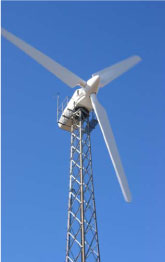 Small and medium size wind generators of about 100 KW each are playing an important role in the power supplied by the Alaska Village Electric Cooperative (AVEC) — a non-profit customer-owned electric co-op serving 52 villages throughout interior and western Alaska.
Small and medium size wind generators of about 100 KW each are playing an important role in the power supplied by the Alaska Village Electric Cooperative (AVEC) — a non-profit customer-owned electric co-op serving 52 villages throughout interior and western Alaska.
Wind power on this scale, and in these conditions, is not cheap. Unlike megawatt scale wind turbines which cost around $1,600 per KW of installed capacity, these smaller generators run around $10,000 per installed KW. Part of that cost is simply a matter of buying on a smaller scale. But according to Brent Petrie, Key Accounts Manager for AVEC, the harsh Alaska conditions are responsible for much of this cost. Building in permafrost has always been tough, especially when that permafrost undergoes seasonal melts that turns it to mush and marsh. As an environmentally sensitive utility, AVEC is careful to minimize damage during installation. Overall, electricity costs from such small scale generation are estimated by Petrie to run around 15 cents per kWh — three to four times the price of larger scale wind farms in milder conditions.
But the same conditions that drive the price of wind electricity for the AVEC customers drive up conventional sources even more. Fuel is shipped by barge to the small isolated communities, or even flows in, meaning that electricity is supplied by diesel generators run on the most expensive of fossil fuels. Since transporting large amount of fuel is an expensive prospect, normally fuel is delivered only once a year.
According to Petrie, AVEC tries to make sure that as a cushion each village has storage capacity for 13 months of fuel. Building a diesel storage facility on permafrost is an expensive prospect too. Combined fuel purchase, shipping, and storage for diesel in these villages runs between 13 cents and 25 cents per kWh — even before purchase and maintenance of generators is considered. Overall, electricity to these villages averages 45 cents per kWh; so the 15 cents per kWh for wind electricity represents a real savings.
The units chosen are adapted to the climate in hundreds of ways large and small. For example, the units are direct drive, rather than using gear boxes, to minimize maintenance. Blades are painted black to maximize heat gain and minimize icing. The nacelles (hubs on which the turbines rote) are enclosed to protect against cold. Since the villages are not part of a larger grid, any power the turbines generate in excess of demand boils water in dump boilers. The heat from these is used for space and hot water needs.
I think this illustrates how useful small-scale wind can be for small villages and farms where connection to a larger grid is unavailable or uneconomical. But it also illustrates why, where a larger grid is practical, large-scale wind will always out compete small-scale wind on cost.
Eric Hoffner recently posted about Edison’s dream of a wind generator for every house. I think the Alaskan experience helps illustrate why that dream is no more realistic today than it was in Edison’s time. Small and micro wind will, as now, be useful for certain small and micro purposes. They won’t replace utilities; the economies of scale in planning, construction, and maintenance are just too large to give up.
 Small and medium size wind generators of about 100 KW each are
Small and medium size wind generators of about 100 KW each are 

